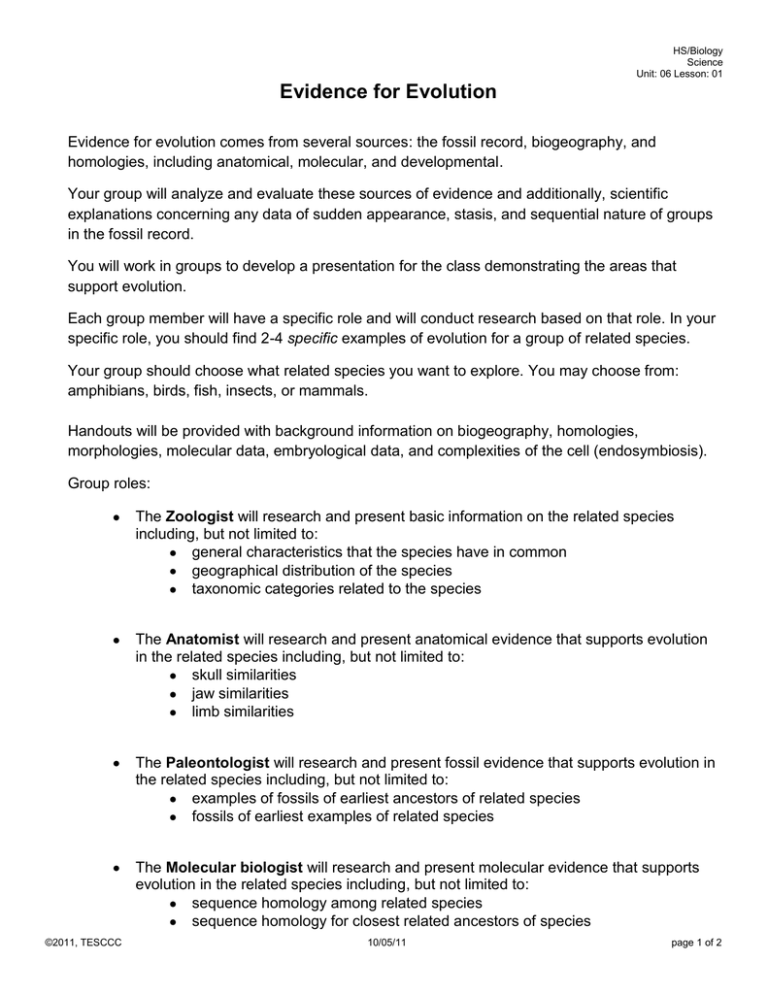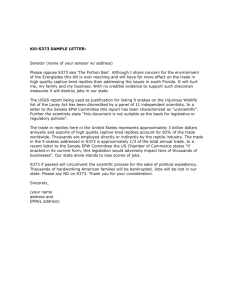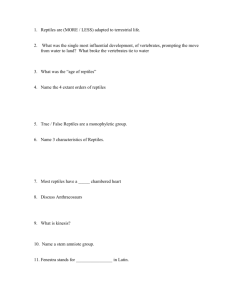Evidence for Evolution
advertisement

HS/Biology Science Unit: 06 Lesson: 01 Evidence for Evolution Evidence for evolution comes from several sources: the fossil record, biogeography, and homologies, including anatomical, molecular, and developmental. Your group will analyze and evaluate these sources of evidence and additionally, scientific explanations concerning any data of sudden appearance, stasis, and sequential nature of groups in the fossil record. You will work in groups to develop a presentation for the class demonstrating the areas that support evolution. Each group member will have a specific role and will conduct research based on that role. In your specific role, you should find 2-4 specific examples of evolution for a group of related species. Your group should choose what related species you want to explore. You may choose from: amphibians, birds, fish, insects, or mammals. Handouts will be provided with background information on biogeography, homologies, morphologies, molecular data, embryological data, and complexities of the cell (endosymbiosis). Group roles: The Zoologist will research and present basic information on the related species including, but not limited to: general characteristics that the species have in common geographical distribution of the species taxonomic categories related to the species The Anatomist will research and present anatomical evidence that supports evolution in the related species including, but not limited to: skull similarities jaw similarities limb similarities The Paleontologist will research and present fossil evidence that supports evolution in the related species including, but not limited to: examples of fossils of earliest ancestors of related species fossils of earliest examples of related species The Molecular biologist will research and present molecular evidence that supports evolution in the related species including, but not limited to: sequence homology among related species sequence homology for closest related ancestors of species ©2011, TESCCC 10/05/11 page 1 of 2 HS/Biology Science Unit: 06 Lesson: 01 An Abbreviated Example: 1. Zoologist Contribution: Related Species: Reptiles a. Examples of reptiles: crocodiles, alligators, turtles, tortoises, snakes, lizards b. Characteristics of reptiles: cold blooded vertebrates, covered in scales, lay eggs c. Evolution of Reptiles: Reptiles evolved about 310 million years ago and flourished during the Age of the Reptiles (the Mesozoic era, about 250 million years ago), during which the first lizards and dinosaurs appeared. 2. Anatomist Contribution: Anatomical Data to Support Evolution of Reptiles a. Images of reptile skulls, jaws, and clawed feet b. Written explanation of similarities seen in different reptile skulls, jaws, and clawed feet 3. Paleontologist Contribution: Fossil Evidence to Support Evolution of Reptiles a. Images of Labryinthodontia fossil, reptile fossil from Bay of Fundy, and reptile fossil from Bromacker Quarry b. Written explanation of similarities seen in fossil evidence relating the extinct species to modern reptiles 4. Molecular Biologist Contribution: Molecular Evidence to Support Evolution of Reptiles a. Homology of sequence data between reptiles and birds b. Homology of sequence data between different types of reptiles 5. Some additional resources include: http://www.pbs.org/wgbh/evolution/library/04/index.html http://www.ncbi.nlm.nih.gov/ http://users.rcn.com/jkimball.ma.ultranet/BiologyPages/E/Endosymbiosis.html http://evolution.berkeley.edu/evolibrary/article/0_0_0/lines_02 (fossil evidence) ©2011, TESCCC 10/05/11 page 2 of 2





